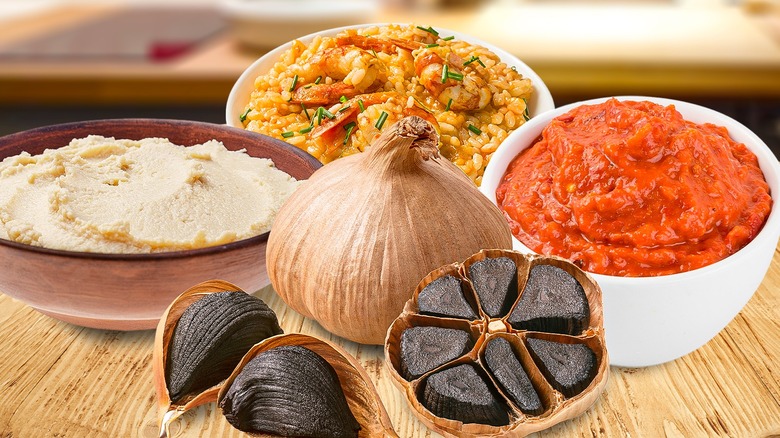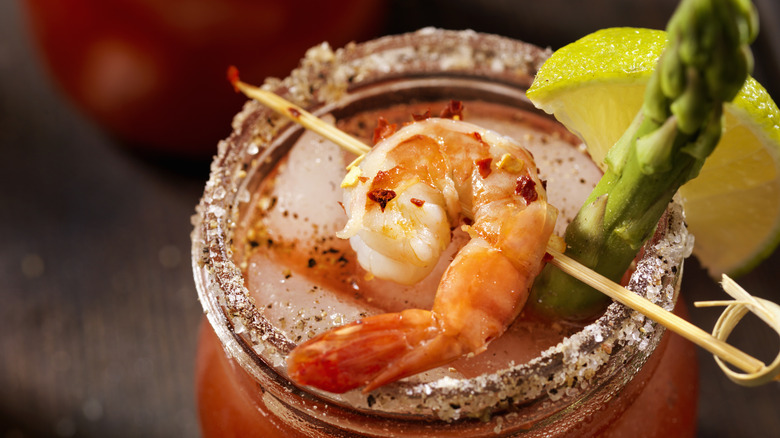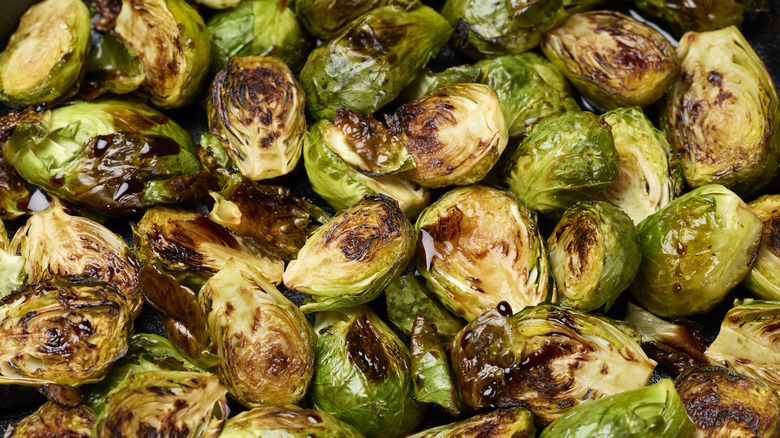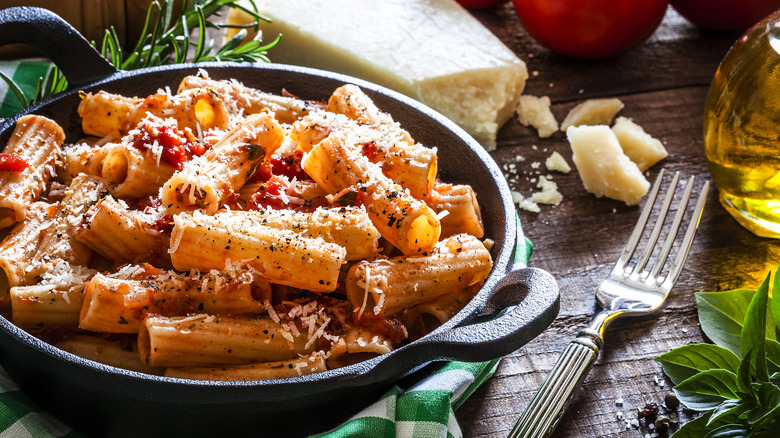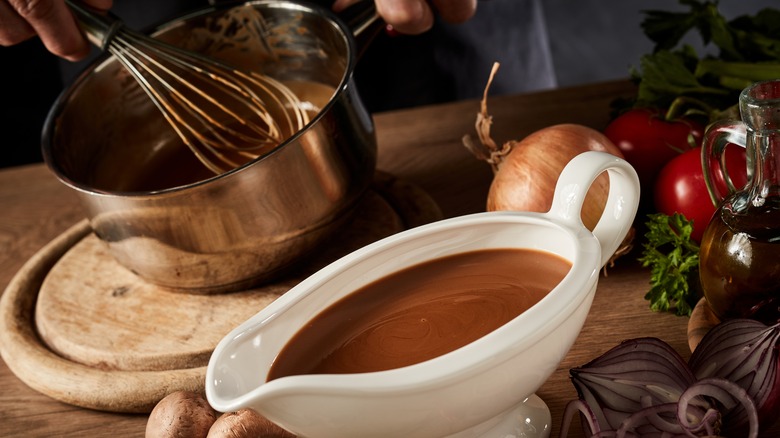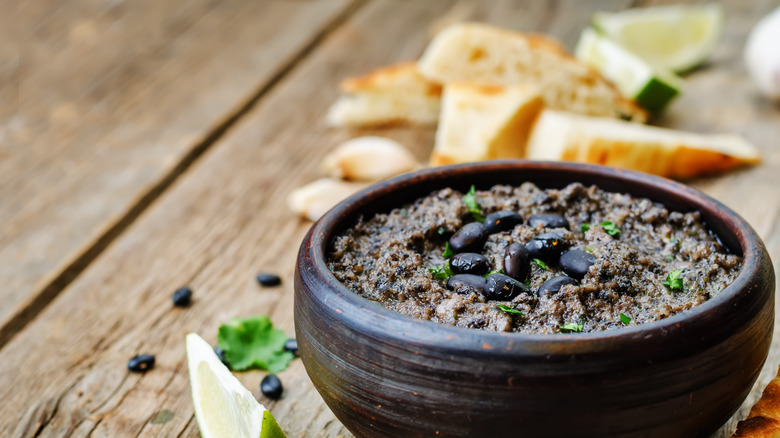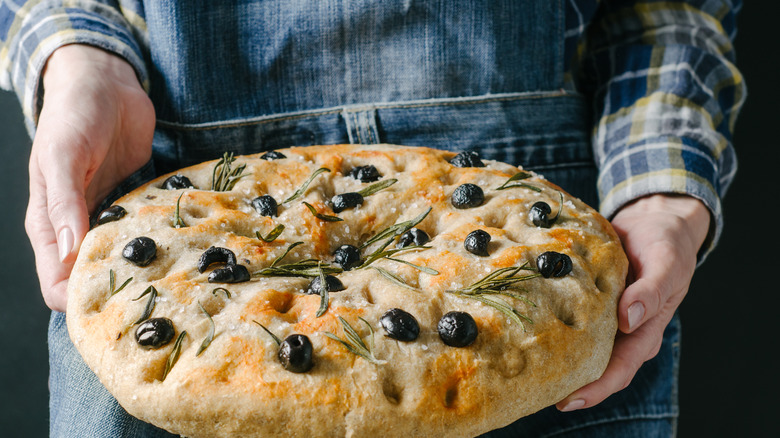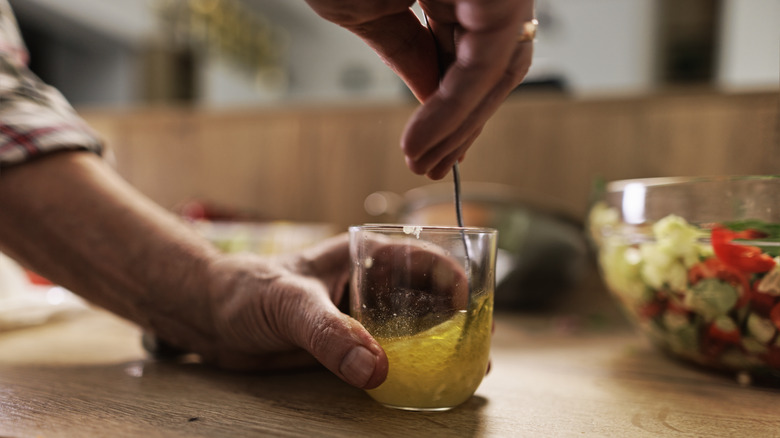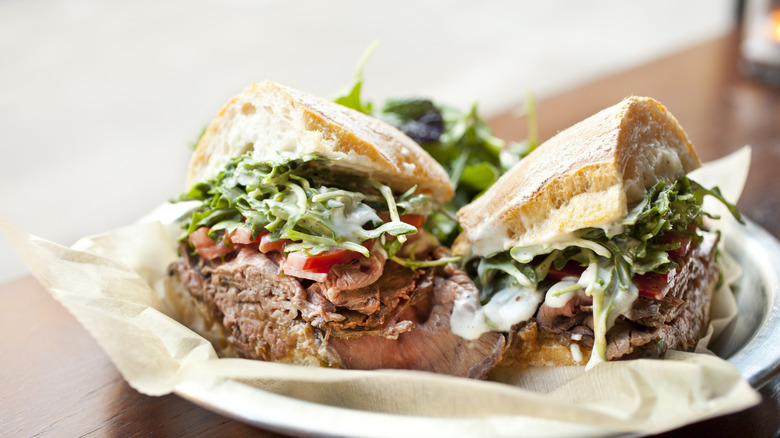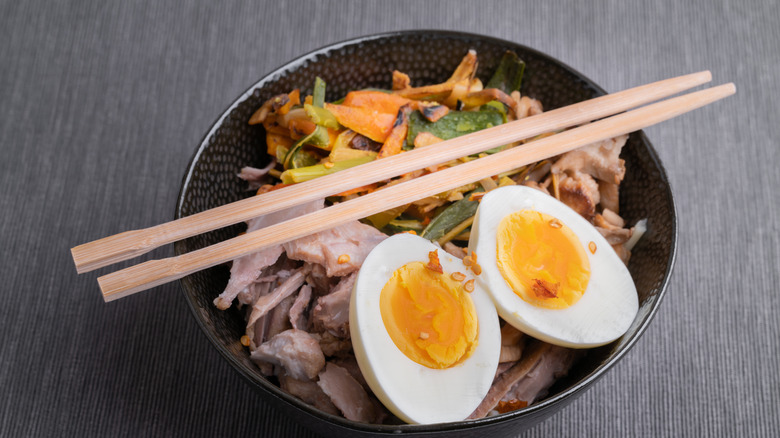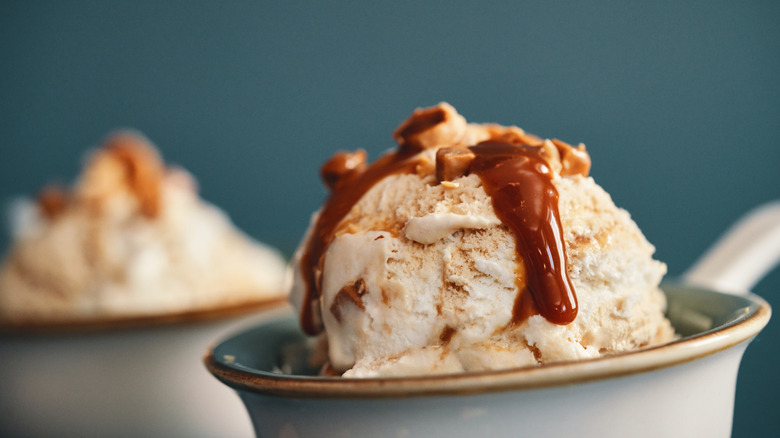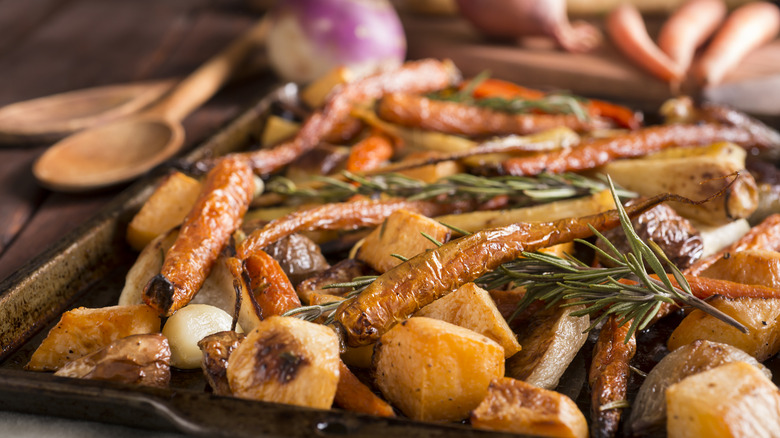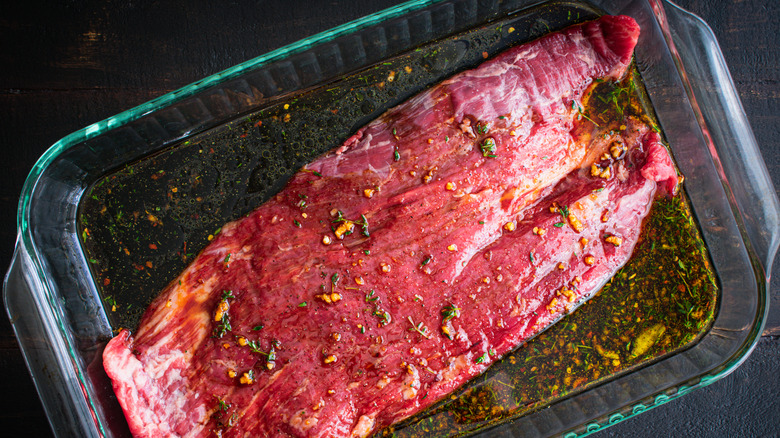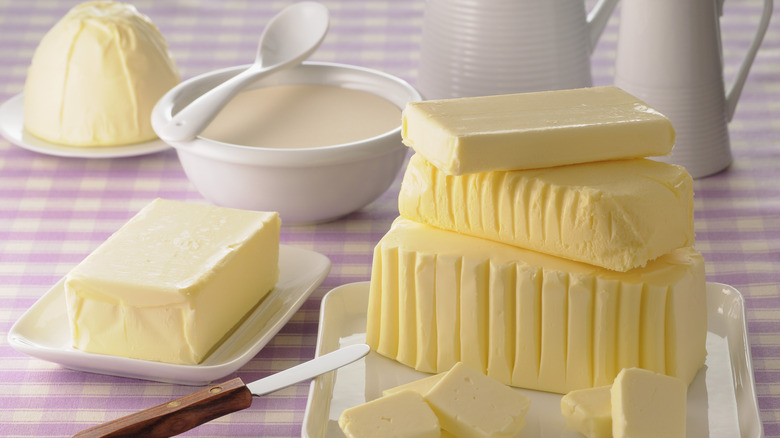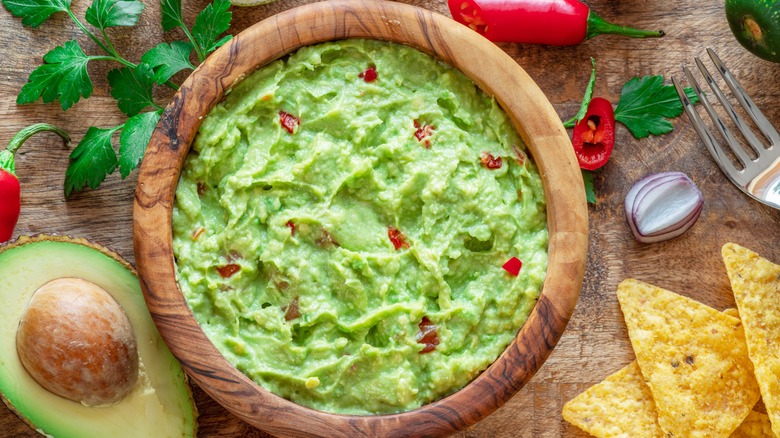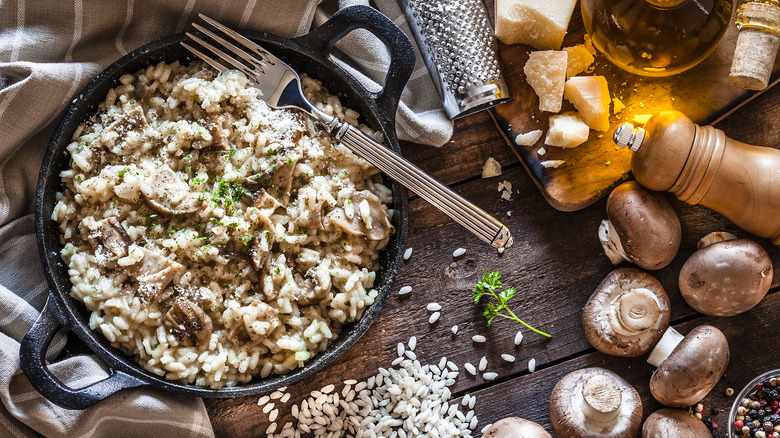15 Unique Ways To Use Black Garlic
We consider ourselves garlic lovers. But the only thing we love more than garlic is its caramelized cousin: black garlic.
Although many people falsely call black garlic a fermented product, it is aged without the help of any bacteria or yeasts. Instead, the garlic is kept under temperature- and humidity-controlled conditions, transforming the allicin-rich, pungent, pale-colored garlic cloves into something much darker. The color isn't the only thing that changes; the process also causes the garlic to become almost candy-like and gummy, with notes of molasses and balsamic vinegar. It's sweet yet slightly savory — which makes it nothing like the plain garlic it started out as.
You can make your own black garlic at home, but it takes several weeks, and the garlicky odor will surely prevent any vampires from paying you a visit. Instead, it's much easier to grab a container from your local ethnic market or specialty grocery store. Once you have the whole cloves, head, or dehydrated powder, you can search out how to cook with black garlic. We've made a list of some of the best ways to utilize this unique ingredient in your kitchen and harness its distinctive flavor, aroma, and texture.
1. Give your Bloody Mary a flavorful boost with black garlic
A Bloody Mary isn't complete without a salted rim. But you shouldn't relegate yourself to plain salt when there is a world of flavorful varieties that will enhance the flavor of your drink. Although the toppings for this boozy brunch drink can be outlandish, swapping plain salt with black garlic salt isn't that outrageous — and it will make all the more difference in your umami-rich beverage. The salt will enhance the garlic's caramelized and fruity notes. Although garlic is primarily umami, it has unmistakably soft, sweet molasses notes that will help subdue the tangy tomato and piquant hot sauce.
If your local stores haven't yet caught on to this delicious seasoning, you can purchase black garlic salt from an online retailer or combine the cloves with salt yourself. Then, coat the rim of your glass with the seasoned salt and add an extra sprinkle to the tomato base to add flavor.
2. Add it to your Brussels sprouts for an umami kick
Brussels sprouts are a cruciferous vegetable that has both staunch supporters and adversaries who can't stand the thought of its sulfurous aroma. If you're a member of the latter camp, you may need to consider that you just haven't had Brussels sprouts prepared the right way. If you don't pair the vegetable with bright, flavor-forward seasonings, it's bound to fall flat.
This is where black garlic comes into the picture. You can add black garlic to your "burnt" Brussels sprouts for a flavorful boost. This recipe features a glaze made with a fat, such as coconut oil, and other seasonings, such as tomato paste, paprika, and balsamic vinegar. The best part about it is that the black garlic flavor will seep into all of the folds of the sprouts and imbue them with flavor. It will quell the acidity of the tomato paste and the vinegar well, resulting in a well-balanced bite and a dish you'll want to serve as part of your next Thanksgiving Day spread.
3. Sprinkle it into your marinara
Nonna may have never tried swapping out regular garlic with black garlic in her pasta sauce, but that's not saying you can't. The key to adding black garlic to your marinara sauce is not to replace all the regular garlic cloves. The black garlic just doesn't have that stinging, bitter flavor that melds into sweetness as it's cooked — which is what your marinara also needs. Rather, the black garlic adds extra complexity and quells the acidity of the tomatoes. Keep a ratio of at least two to one of regular garlic to black garlic. You'll get the traditional taste of garlic with the spunkiness of its caramelized cousin.
Marinara isn't the only pasta sauce that can use the royal treatment. You can make an Alfredo sauce infused with black garlic. Start with black garlic compound butter, and add in all of your regular additions, like Parmesan, cream, Pecorino Romano, and a parsley garnish.
4. Give your gravy an edge with black garlic
Pan sauces and black garlic are a match made in heaven. The gravy can loosen up any cooked alliums, like garlic or onions, from the walls of the pan and infuse the sauce with an array of herbal accompaniments, including rosemary, thyme, and sage. Customize your gravy with beef, chicken, or vegetable stock, and you'll have something hearty to spoon over your mashed potatoes or steak dinner. The only thing this recipe is missing is a sweet kick, which can be achieved with black garlic.
The key to integrating black garlic into your gravy recipe is not to add it to the pan at the beginning of the cooking process, as you might do with normal onions. Since black garlic is so soft, it will merely stick, schmear, and inevitably burn on the sides of the pan. Instead, crush the cloves into a thick, rich paste and add it at the end with your cream sauce. This will preserve the sweet, molasses notes of the sauce, which will perfectly finish out your gravy's flavor, regardless of what type of stock you use.
5. Puree it into your favorite hummus recipe
If you're anything like us, you go for the garlic hummus before the plain or roasted red pepper variety. But the only hummus we would even consider grabbing instead is one made with black garlic.
You can make black garlic hummus without having to even turn on your stove. Plus, you'll never have to peel chickpeas again if you soak your dried beans in a mixture of baking soda and water. Give the beans a gentle rub with your hands and rinse off the residual bicarbonate. Once your chickpeas are skinless, you can add them to a food processor and blitz them with your black garlic, plain garlic, tahini, and oil.
Although black garlic hummus is already special enough, you can also up the ante by adding extra spices like parsley to curb some of the tahini's nuttiness and fattiness. The result is a balanced spread perfect for dipping pita chips into or serving over a fresh salad.
6. Combine it with your favorite bread
It's fair to say that garlic bread is a beloved food. Not only does it hit the spot when served with a large, veggie-forward salad, but it's also the ideal vehicle for sopping up pasta sauce. Instead of just coating your store-bought rolls with plain, minced garlic and calling it a day, take things a step further with black garlic.
Start by mixing your black garlic with softened butter and any additional seasonings you plan to add to your bread. Black garlic plays well with herbaceous notes of thyme and fresh parsley, but you can tweak the seasoning depending on what you have available. Slather your black garlic butter onto the top of your bread, as well as into the nooks and crannies of each slice, before tossing it in the oven and baking until it's warm, soft, and delicious.
You can also stud your focaccia with black garlic. If you love the flavor, consider adding the paste to the bread dough itself to add extra flavor, or stick to poking the cloves on the top of your bread with tomatoes, red onions, and other seasonings before baking it.
7. Incorporate it into your salad dressing
Salad dressings and vinaigrettes are vectors for flavor. Not only do you have the punchy notes of vinegar and high-quality oil, but you can also play around with ingredients like orange juice, tahini, and spices to give it an edge. If you're looking to upgrade your salad dressing from plain to gourmet, try adding black garlic to the mix.
There is a range of salad dressing bases that crave the sweetness and molasses undertones of black garlic. You can whip up a vinaigrette by making an emulsion flavored with black garlic, plain garlic, shallots, mustard, and a hint of sweetener (like honey). The sweet elements in this dressing will help tame even the sharpest arugula and give life to a sad, plain bowl of romaine.
But vinaigrettes aren't the only dressing that can use a good one-two punch from black garlic. You can even grind it up into a paste and add it to your ranch or other creamy dressing to complement shallots, onions, and plain garlic. These dressings often feature a tangy element, like buttermilk or vinegar, which crave a sweetness to mellow them out. The black garlic delivers on this front and makes for a dressing that even ranch snobs can't say no to.
8. Make a tasty aioli for your sandwich
Mayonnaise is out, and aioli is in. And we couldn't be more thankful.
Aioli is essentially dressed-up mayonnaise — and it's no stranger to garlic. You can make an easy roasted garlic aioli by mixing the softened cloves into your food processor with other seasonings, like lemon juice, mustard, jarred mayonnaise, and Worcestershire sauce. You'll want to follow the same recipe when you add black garlic to the mix. Pop the softened cloves into the food processor with your other seasonings and mayo and blitz it until it's smooth.
There are seemingly no limits to what you can do with your newfound favorite spread. It can be used as a dipping sauce for sweet potato fries or slathered on a grilled burger patty in lieu of other condiments. This condiment is also a great spread for your regular ol' sandwich. The flavors will meld even more if you let it sit in your fridge for a few days before using it.
9. Give your ramen more flavor with black garlic
Ramen embodies one word: soothing. There's something magical about a piping hot bowl of noodles, thinly sliced proteins floating around, and a perfectly soft-boiled egg on top. The one thing your bowl is missing, though, is a mashup of sweet and savory.
Black garlic is an excellent addition to your bowl of ramen because it has subtly sweet undertones. You'll want to add this ingredient to the pan with your other aromatic ingredients, like shallots, regular garlic, and scallions, to allow the flavors to fuse together. This recipe can be used for many different kinds of ramen, including shoyu and tonkotsu. It's a great option for vegetable-based ramen because it has some of the umami and savory flavors that vegetables lack.
It's important to note that we're still talking about the whole black garlic cloves — not the black garlic oil that's commonly added to ramen bowls. The latter is a burnt garlic oil made by essentially singeing minced garlic together with sesame oil and regular oil. The result is a greasy condiment that is acrid in flavor, which is nothing like the subtly sweet and piquant black garlic cloves.
10. Flavor your ice cream with it
Think of the look on your face when you bite into a scoop of what you thought was black cherry ice cream, only to find that those are actually cloves of black garlic. Ha!
All jokes aside, black garlic can be an unexpected (in more ways than one) addition to your homemade ice cream. Rather than leaving chunks of garlic in your ice cream, you'll want to start out by making it into a thick paste. You can also swap this out with a seasoning powder, which will more readily diffuse into the cream. Then, add the paste to the pan with your other ice cream ingredients sans egg yolks. This will allow the flavor of the garlic to infuse into the cream, which will then make for a rich combination and luscious ice cream.
As you can imagine, pairing black garlic ice cream with a sundae is very difficult because few toppings would keep the center of attention on the black garlic. You'll also want to channel the molasses flavor of the garlic by adding other sweet elements, like honey, vanilla, or brown sugar.
11. Pair it with roasted root vegetables
Eating a fresh, crunchy carrot is a great sensory experience. But eating a perfectly roasted, subtly sweet roasted carrot is also one of life's simple pleasures. The cooking process helps concentrate the sweet flavors and lends a beautiful taste to these humble root vegetables. You don't have to stick to carrots either; rutabaga, sweet potatoes, and parsnips can all benefit from a roast in the oven.
If you want to channel the sweetness of your root vegetables even more, turn to black garlic for a helping hand. Its sweetness and subtle savory notes pair well with a range of other seasonings, like dried thyme, rosemary, and balsamic. To ensure the black garlic flavors the whole tray of root veggies, you'll want to chop it up into small pieces or make a sauce in your food processor. Toss your veggies in the sauce before sliding them into the oven.
12. Use a black garlic marinade to season your steak
Steak marinades are a great way to add flavor to your protein and give it a tasty outer crust. Although black garlic may not be a common ingredient in store-bought marinades, it does add a subtle sweet flavor that you'd find from similar ingredients, like molasses and brown sugar. To add this ingredient to your steak marinade, puree it with other flavorful ingredients, like pomegranate molasses, maple syrup, and balsamic vinegar. Then, cover your steak in it and let it sit overnight so that the flavors can soak in. Make sure to save some of the sauce to heat up on the stove and then serve over your steak.
Although steak is an excellent pairing for the sweet black garlic, you can also use it for pork or chicken, too. You can also finish your steak with a compound butter to infuse flavor into your meat.
13. Make a compound butter out of black garlic
Compound butter is one of those recipes that absolutely everyone should know how to make. Integrating an ingredient into a saturated fat is so simple and easy. From there, you can spread it onto your steak, toast, or corn on the cob.
The easiest way to make compound butter is to use a food processor. Add the black garlic to the appliance with cold butter (as softened butter will get too soft with the heat of the blades) and any other flavorful herbs or aromatics. You should use unsalted butter for your black garlic compound butter because you can easily tweak the recipe to fit your palate and add more salt as needed.
Then, you can place the softened butter onto plastic wrap and roll it up into a log. It's best to allow the butter to sit in the fridge to solidify and to encourage the flavors to meld together before using it.
14. Substitute black garlic for regular garlic in your guacamole
Chips and salsa just don't hit the same way that chips and guac do. But if you want to make a guacamole that all of your partygoers will love, swap out some of the regular garlic for black garlic. The regular allium has a slightly spicy bite, while the black garlic has a more subtle sweet flavor that will introduce something novel into your dip.
The key to making a good black garlic guacamole is not to go overboard. You'll need to add only a single clove per avocado. Otherwise, you risk shifting the balance of your dip entirely. You'll also want to pulverize the clove into a paste using your food processor to ensure that there are no clumps of it in your finished dip. You can add your avocados to the appliance if you want a creamy consistency, or transfer your garlic paste into a separate bowl and hand-mash your fruit for something chunkier.
15. Add black garlic to your risotto
Black garlic and risotto is the heavenly combination you didn't know you needed. It's even better when there are massive pieces of mushroom floating around to add that umami bite. Once you add your rice to the pot, you can stir in your chopped black garlic. Then, as with all good risottos, you'll need to add stock to your arborio rice incrementally.
This flavorful addition pairs well with traditional risotto seasonings, like thyme, rosemary, and sage. It can also be modified to be entirely plant-based using vegetable stock and plant-based butter; the black garlic adds a tame, savory punch with some sweet notes. You can further this umami addition by adding mushroom powder to the butter and meaty shiitakes or porcini mushrooms to the rice dish. Or, go all out with chicken stock and copious amounts of Parmesan cheese to give your dish a salty-savory kick.
